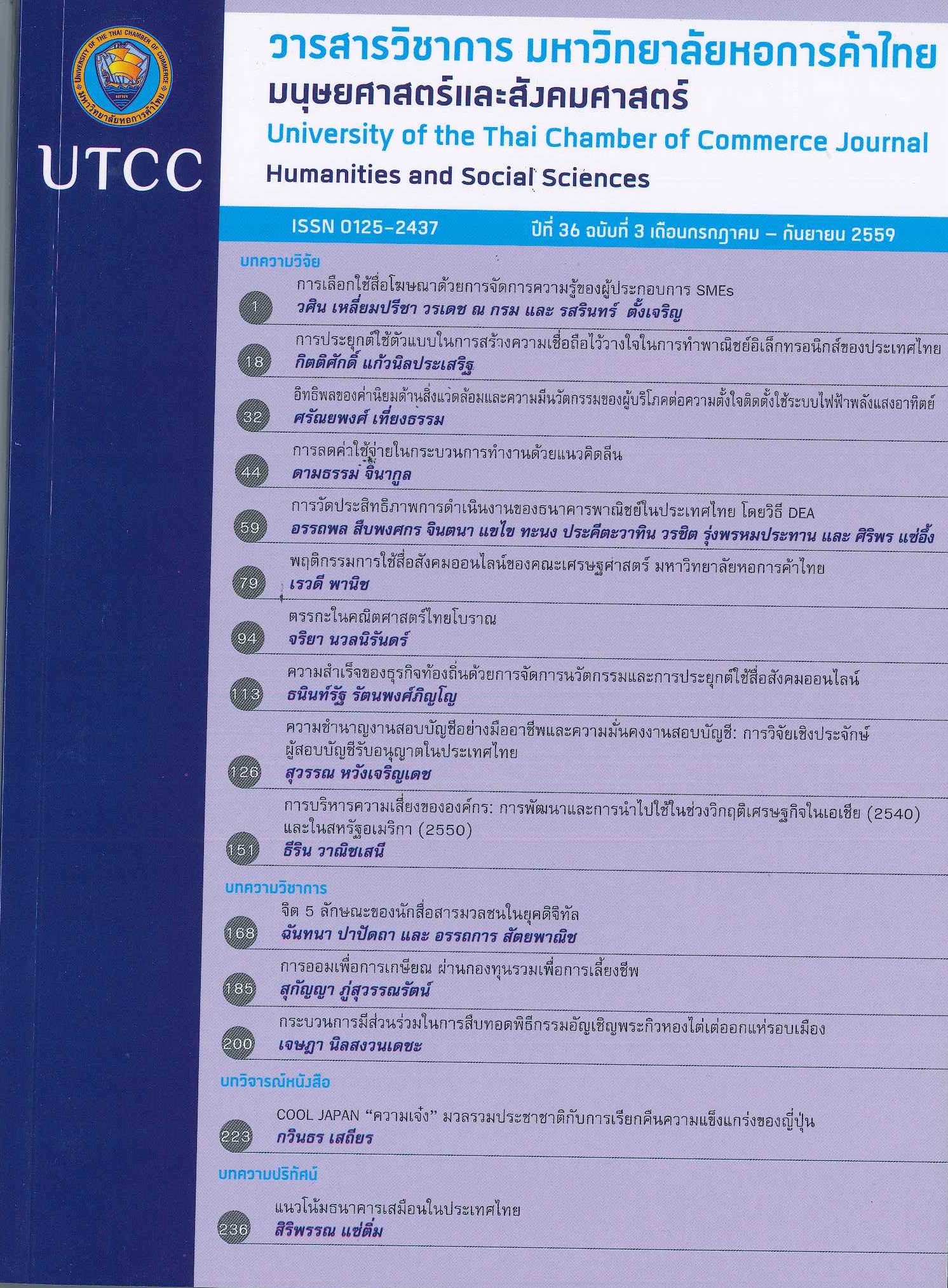The Application of a Trust-Building Model on Electronic Commerce in Thailand
Main Article Content
Abstract
The purpose of this research was to study electronic commerce development of a trust-building model based on products and services buying behavior of Thailand Internet users.The result from the 18-month study revealed firstly, the high level of initial trust influenced the trusting beliefs and trusting intentions. Secondly, the initial trust was related to personal factors, such as attitude, experience, disposition to trust, institution-based trust and risk. Thirdly, the trusting beliefs were related to website factors, such as advertisement, web design, brand, ease of use and content update frequency. Fourthly and finally, the website factors, such as advertisement, web design and content, and the customer degree of need factor interacted with the trusting beliefs at a significant 0.05 level of confidence.
Article Details
ลิขสิทธิ์ของบทความ
ผลงานที่ได้รับการตีพิมพ์ถือเป็นลิขสิทธิ์ของมหาวิทยาลัยหอการค้าไทย ห้ามมิให้นำเนื้อหา ทัศนะ หรือข้อคิดเห็นใด ๆ ของผลงานไปทำซ้ำ ดัดแปลง หรือเผยแพร่ ไม่ว่าทั้งหมดหรือบางส่วนโดยไม่ได้รับอนุญาตเป็นลายลักษณ์อักษรจากมหาวิทยาลัยหอการค้าไทยก่อน
References
Head, M., and Hassanein, K. 2002. “Trust in E-Commerce: Evaluating the Impact of Third-Party Seals.” Quarterly Journal of Electronic Commerce 3,3: 307-325.
Kraemer, C. H., and Thiemann, S., 1987. How Many subjects? Statistical Power Analysis in Research. London: SAGE.
Lamsal, P. 2001. Understanding Trust and Security. Helsinki: Department of Computer Science, University of Helsinki.
McKnight, D. H., Cummings, L. L., and Chervany, N. L. 1998. “Initial Trust Formation in New Organizational Relationships.” Academy of Management Review 23, 3: 473-490.
McKnight, H., Choudhury, V., and Kacmar, C. 2002. “The Impact of Initial Consumer Trust on Intentions to Transact with a Web Site: A Trust Building Model.” Journal of Strategic Information System 11,3|4 : 297-323.
Pennanen, K. 2006. “How Consumers Build Trust in E-Commerce: Towards a Trust Formation Model.”In S. Gonzaks and D. Luna (eds.), Latin American Advances in Consumer Research I, pp. 38-43. Duluth: Association for Consumer Reseach.
Rattanawicha, P., and Esichaikul, V. 2005. “What Makes Web Sites Trustworthy?: A Two Phase Empirical Study.” International Journal of Electronic Business 3, 2: 110-136.
Sukrat, Supattana. 2015. "E-commerce Business Directions of OTOP." University of Thai Chamber of Commerce Journal 35, 1:50-64. (in Thai).
สุพัฒธณา สุขรัตน์. 2558. “แนวทางการดำเนินธุรกิจพาณิชย์อิเล็กทรอนิกส์ของกลุ่มสินค้าหนึ่งตำบลหนึ่งผลิตภัณฑ์.” วารสารวิชาการ มหาวิทยาลัยหอการค้าไทย 35, 1:50-64.
Thailand. National Electronics and Computer Technology Center. 2010. Thailand E-Commerce Situation Report in 2010. Bangkok: National Information Technology Committee Secretariat. (in Thai).
ศูนย์เทคโนโลยี อิเล็กทรอนิกส์และคอมพิวเตอร์. 2553. รายงานผลสำรวจกลุ่มผู้ใช้อินเทอร์เน็ตในประเทศไทย. กรุงเทพมหานคร: สำนักงานเลขานุการคณะกรรมการเทคโนโลยีสารสนเทศแห่งชาติ.
Thailand. National Statistical Office. 2011. Thailand E-Commerce Situation Report in 2010. Bangkok: Thammada Press. (in Thai).
สำนักงานสถิติแห่งชาติ. 2554. รายงานผลที่สำคัญสำรวจสถานภาพการพาณิชย์อิเล็กทรอนิกส์ของประเทศไทย พ.ศ. 2553. กรุงเทพมหานคร: ธรรมดาเพรส.
Turban, Efraim, and King, David. 2008. Introduction to E-Commerce. Upper Saddle River, NJ: Prentice Hall.
Vanichbuncha, Kanlaya. 2006. Statistics for Research. Bangkok: Chulalongkorn University Printing House. (in Thai).
กัลยา วานิชย์บัญชา. 2549. หลักสถิติสำหรับงานวิจัย. กรุงเทพมหานคร: โรงพิมพ์แห่งจุฬาลงกรณ์มหาวิทยาลัย


